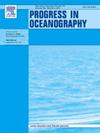Does the oceanographic response to wind farm wind-wakes affect the spring phytoplankton bloom?
IF 3.6
3区 地球科学
Q1 OCEANOGRAPHY
引用次数: 0
Abstract
Large offshore wind farms (OWFs) will be deployed in the North Sea, potentially causing multiple effects on marine ecosystems some of which may be synergistic with climate change. This study modelled the oceanographic bio-physical response to anticipated atmospheric wind farm wakes in the north-west North Sea. The wind wake was included as a reduction of the wind speed into the atmospheric forcing of the Finite Volume Community Ocean Model (FVCOM) coupled with the European Regional Sea Model (ERSEM) from three OWFs using a year with available in situ data for model validation. The spatial distribution of physical variables and chlorophyll a (Chl-a) was compared between model runs with and without OWFs during three temporal subdivisions (pre-bloom, bloom and post-bloom) of the spring-summer period. Overall, across the entire period there was a 7 % decrease in Chl-a concentration, with the decrease being more pronounced during the bloom period. However, there was a slight increase in Chl-a in the post-bloom period. At higher temporal (12 h) and spatial (> 1 km) scales, significant changes in Chl-a were identified throughout the vertical water column and during the prevailing south-west and north-west winds, which generated a persistent upwelling/downwelling dipole across the simulated time series. The spatial variations of potential energy anomaly (PEA) and Chl-a were the most informative variables as they displayed distinct values and spatial distributions linked to the upwelling/downwelling dipoles. The downwelling cell was characterised by fresher and warmer waters, especially at the surface, with areas displaying an increase in stratification with a resulting decrease of Chl-a in seasonally stratified waters. On the other hand, upwelling regions were characterised by saltier and cooler waters with increasing PEA in permanently mixed and intermittently stratified waters showing consistently increased Chl-a production. The changes to levels of stratification are ecologically important as they change the vertical characteristics of the water column differently over a seasonal cycle. The analyses confirmed that it is critical to identify the temporal and spatial scales at which important changes to the physics and Chl-a production occur as they will play a role in assessing the range of impacts of OWFs.
海洋学对风电场风尾的反应会影响春季浮游植物的繁殖吗?
大型海上风电场(owf)将部署在北海,可能对海洋生态系统造成多重影响,其中一些可能与气候变化协同作用。本研究模拟了对北海西北部预期大气风电场尾迹的海洋生物物理响应。在有限体积群落海洋模式(FVCOM)和欧洲区域海洋模式(ERSEM)的大气强迫中,风尾流作为风速的减少被包括在内,这些模式来自三个owf,使用一年的现场数据进行模式验证。在春夏期3个时间区间(开花前、开花后和开花后)比较了有和无OWFs模式运行的物理变量和叶绿素a (Chl-a)的空间分布。总体而言,在整个时期,Chl-a浓度下降了7%,在开花期间下降更为明显。然而,在开花后,Chl-a有轻微的增加。在较高的时间(12 h)和空间(>;1 km)尺度下,在整个垂直水柱以及盛行的西南风和西北风期间,确定了Chl-a的显著变化,这在整个模拟时间序列中产生了持续的上升/下降偶极子。势能异常(PEA)和Chl-a的空间变化是最具信息量的变量,它们与上升/下降偶极子有关,具有不同的值和空间分布。下流细胞的特点是更新鲜和温暖的水,特别是在表面,区域显示分层增加,导致季节性分层水的Chl-a减少。另一方面,上升流区域的特点是海水更盐、更冷,在永久混合和间歇分层的水域中,PEA增加,Chl-a产量持续增加。分层水平的变化在生态学上是重要的,因为它们在一个季节循环中不同地改变了水柱的垂直特征。分析证实,确定物理和Chl-a产生发生重要变化的时间和空间尺度至关重要,因为它们将在评估owf的影响范围中发挥作用。
本文章由计算机程序翻译,如有差异,请以英文原文为准。
求助全文
约1分钟内获得全文
求助全文
来源期刊

Progress in Oceanography
地学-海洋学
CiteScore
7.20
自引率
4.90%
发文量
138
审稿时长
3 months
期刊介绍:
Progress in Oceanography publishes the longer, more comprehensive papers that most oceanographers feel are necessary, on occasion, to do justice to their work. Contributions are generally either a review of an aspect of oceanography or a treatise on an expanding oceanographic subject. The articles cover the entire spectrum of disciplines within the science of oceanography. Occasionally volumes are devoted to collections of papers and conference proceedings of exceptional interest. Essential reading for all oceanographers.
 求助内容:
求助内容: 应助结果提醒方式:
应助结果提醒方式:


